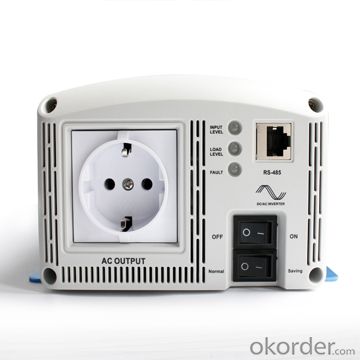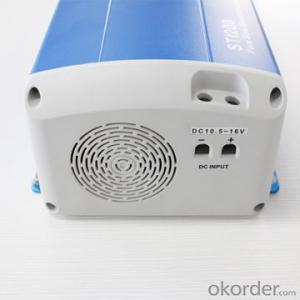Solar Inverter and Battery - Off-grid Pure Sine Wave Solar Inverter 200W, DC 12V to AC 220/230V, STI200
- Loading Port:
- China Main Port
- Payment Terms:
- TT or LC
- Min Order Qty:
- -
- Supply Capability:
- -
OKorder Service Pledge
OKorder Financial Service
You Might Also Like
Description
STI series is a sine wave power frequency inverter which can convert 12V or 24V DC to 220VAC or 230VAC 50Hz based on full digital and intelligent design. The inverter can be applied in many fields especially for solar photovoltaic power system.

Features:
·Complete isolation-type inverter technology, noiseless output
·Adoption of advanced SPWM technology, pure sine wave output
·Dynamic current loop control technology to ensure inverter reliable operation.
·Wide DC input voltage range
·Excellent EMC design
·Low output harmonic distortion(THD≤3%)
·LED indicators display input voltage range, load power range, normal output & failure state
·Optional energy saving mode
·Wide working temperature range (industrial level)
·Continuous operation at full power
Protections:
·Output Short Circuit protection
·Overload protection
·Input reverse polarity protection
·Input low voltage protection
·Input over voltage protection
·Inverter abnormal protection
·Overheating protection


Specification:
Model | STI200-12-220 | STI200-24-220 | |
STI200-12-230 | STI200-24-230 | ||
Nominal battery voltage | 12V | 24V | |
Input voltage range | 10.5~16V | 21~32V | |
Consumption no load(ON) | ≤4W | ≤5W | |
Consumption no load (Saving) | ≤2W | ≤2W | |
Output voltage | AC220/230V±3% | ||
Continuous power | 200VA | ||
Power 10sec | 300VA | ||
Power 1.5sec | 400VA | ||
Surge power | 640VA | ||
Output mode | Single Phase | ||
Wave form | Pure Sine Wave | ||
Frequency | 50Hz±0.2% | ||
Distortion THD ( resistive load) | ≤ 3% | ≤ 2% | |
Efficiency at rated power | ≥81% | ≥85% | |
Max. efficiency | ≥88% | ≥89% | |
Dimension | 315*166*101mm | ||
Net weight | 4.5kg | ||
Working temperature | -20℃~ +50℃ | ||
Humidity | < 95%(non-condensation) | ||
Altitude | < 5000m(Derating to operate according to IEC62040 at a height exceeding 1000 m) | ||
FAQ
Does inverter long warranty mean high quality?
The European Sunny Boys are only warrantied for 5 years. iPhones only have a one year warranty. Does that mean Apple products aren't reliable? Enphase offers a 25 year warranty on their inverters but only one year on their monitoring. Does this mean their monitoring is not as reliable as their inverter? Of course not.
Offering long warranties have very real costs. If we were to offer a 25 year warranty, we would have to hold a higher reserve on our balance sheet, making our products more expensive. We think that our customers would rather have our high quality products at a lower cost.
- Q: How does a solar inverter handle power quality disturbances?
- A solar inverter handles power quality disturbances by employing various protective measures. It typically includes features such as voltage regulation, frequency control, and surge protection. In the case of voltage fluctuations, the inverter adjusts the output voltage to maintain a stable power supply. Similarly, it monitors the grid frequency and adjusts its output frequency accordingly. Moreover, it incorporates surge protection mechanisms to safeguard against power surges and voltage spikes. Overall, a solar inverter efficiently manages power quality disturbances to ensure a reliable and stable electricity supply.
- Q: What is the role of a solar inverter in preventing electrical faults?
- The role of a solar inverter in preventing electrical faults is to convert the direct current (DC) generated by solar panels into alternating current (AC) that can be used by appliances and the electrical grid. By regulating and controlling the flow of electricity, a solar inverter ensures that the voltage and frequency levels are within acceptable limits, preventing overloading, overheating, and electrical faults that could potentially damage the system or cause safety hazards.
- Q: What is the role of Maximum Power Point Tracking (MPPT) in a solar inverter?
- The role of Maximum Power Point Tracking (MPPT) in a solar inverter is to optimize the efficiency and performance of the solar panel system. MPPT technology allows the solar inverter to constantly adjust the operating voltage and current of the solar panels to ensure they are operating at their maximum power point, where the panel generates the most power. This increases the overall energy production of the solar system and maximizes the utilization of the available sunlight.
- Q: How does a solar inverter impact the payback period of a solar system?
- A solar inverter plays a crucial role in converting the direct current (DC) electricity generated by solar panels into usable alternating current (AC) electricity for household or grid consumption. The efficiency and performance of the solar inverter directly impact the overall energy production of the solar system. A higher quality and more efficient solar inverter can maximize the electricity generation, reducing the payback period of the solar system. Conversely, a low-quality or inefficient solar inverter may result in lower energy output, potentially extending the payback period of the solar system.
- Q: Can a solar inverter be used with bifacial solar panels?
- Yes, a solar inverter can be used with bifacial solar panels. Bifacial solar panels have the ability to capture sunlight from both sides, making them more efficient. A solar inverter is responsible for converting the DC power generated by solar panels into usable AC power for homes or businesses. Therefore, it can easily be used with bifacial solar panels to ensure efficient power conversion and utilization.
- Q: How does a solar inverter handle low light conditions?
- A solar inverter handles low light conditions by utilizing advanced technologies such as maximum power point tracking (MPPT) and voltage boosters. These technologies enable the inverter to efficiently convert the limited amount of sunlight available during low light conditions into usable electricity. The MPPT algorithm adjusts the voltage and current to maximize the power output, while voltage boosters increase the voltage to compensate for the reduced sunlight. This ensures that the solar inverter can still generate electricity even in low light conditions.
- Q: How do you connect a solar inverter to solar panels?
- To connect a solar inverter to solar panels, the DC output of the solar panels needs to be connected to the DC input of the inverter. This is usually done using appropriately sized and rated solar cables and connectors. The positive terminal of the solar panel is connected to the positive terminal of the inverter, and the negative terminal of the solar panel is connected to the negative terminal of the inverter. Properly following the manufacturer's instructions and guidelines is crucial to ensure a safe and efficient connection.
- Q: What are the methods of photovoltaic grid-connected inverter control
- Sine wave output inverter control integrated circuits, sine wave output of the inverter, the control circuit can be used microprocessor control, such as INTEL company produced 80C196MC, Motorola produced MP16 and MI-CROCHIP company PIC16C73 and so on, these single-chip microcomputer has a multi-channel PWM generator,
- Q: Can a solar inverter be used in a hybrid solar system?
- Yes, a solar inverter can be used in a hybrid solar system. A hybrid solar system combines both solar power and another source of energy, such as a battery or grid power. The solar inverter is responsible for converting the DC power generated by the solar panels into AC power that can be used in the home or fed back to the grid. In a hybrid solar system, the solar inverter would still perform this function, allowing the system to utilize both solar and other energy sources efficiently.
- Q: Are solar inverters weather-resistant?
- Yes, solar inverters are typically weather-resistant. They are designed to withstand various weather conditions such as rain, snow, and extreme temperatures. However, it is important to note that prolonged exposure to harsh weather conditions could potentially affect their performance and lifespan. Regular maintenance and proper installation can help ensure their durability and longevity.
Send your message to us
Solar Inverter and Battery - Off-grid Pure Sine Wave Solar Inverter 200W, DC 12V to AC 220/230V, STI200
- Loading Port:
- China Main Port
- Payment Terms:
- TT or LC
- Min Order Qty:
- -
- Supply Capability:
- -
OKorder Service Pledge
OKorder Financial Service
Similar products
Hot products
Hot Searches
Related keywords






























